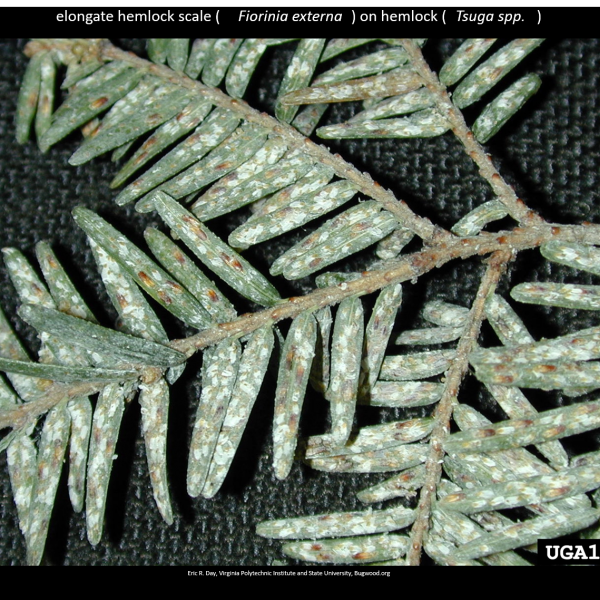
Hemlock trees in southern Vermont have been threatened with hemlock woolly adelgid for several years. They have also been stressed by drought for two seasons. Recently another stressor has been added to the mix. Elongate hemlock scale (EHS) has been found in stands of hemlock in Windham County, occasionally in conjunction with hemlock woolly adelgid.
Like the adelgid, elongate hemlock scale is an invasive forest insect from Asia. Also known as the fiorinia scale, this serious pest is thought to have been introduced from Japan. It was first observed in 1908, in Queens, New York and is now found from Maine to Virginia. In 2014 it was discovered in Vermont by a First Detector.
The elongate hemlock scale is an armored scale; its soft body is protected by a waxy covering. EHS is most commonly found on hemlocks, spruces and fir. Other hosts include cedars, Douglas-fir, pines and yew.
This scale feeds on the underside of needles by inserting its sucking/piercing mouthparts into the needles and withdrawing vital fluids and nutrients. Feeding damage appears as yellow banding on the upper surface of the needles. Eventually growth slows, twigs die and the crown thins. Infested trees become susceptible to secondary pests like the hemlock borer and Armillaria root rot. Mortality may occur within 10 years. Outbreaks often increase in intensity following stresses from other causes like drought and hemlock woolly adelgid.
The waxy cover of the female is about 1.5 mm long. It is elongated in shape, flattened against the needle and yellowish to brownish orange in color. Underneath the cover, the adult female, eggs and crawler stage are all yellow.
Immature male covers are white and smaller. Waxy secretions from settled crawlers may occasionally build up to give the underside of needles a white appearance that may be misidentified as hemlock woolly adelgid. Adult males have one pair of wings.
EHS generally has just one generation per year in Vermont. Mature males use their wings to seek females. After mating they die. In the spring, females lay eggs under their protective waxy scale. They may lay as many as 20 eggs. Upon hatching, the first instar nymphs, known as crawlers, move to new feeding sites on the underside of hemlock needles. Crawlers may be more widely disseminated by wind and birds. After settling to feed, the instars will molt several times. The females have three developmental stages; males five.
Some native parasitoids and predators may have some effect on EHS levels, but not usually significant enough to control the population. Reducing stress to host trees can help to avoid sudden population growth. Keep trees watered in times of drought, if possible. Avoid using nitrogen fertilizers, as these enhance EHS survival and growth. Broad spectrum insecticides can sometimes set the stage for population resurgence by killing natural enemies of EHS. Ornamental trees can be protected with carefully timed applications of horticultural oil or labeled pesticides. Sanitation or salvage cuts can be used in forested situations to prevent population build up and spread.
To report suspected EHS, consult vtinvasives.org or call 802-879-5687.
Article Credit: Jim Esden, Vermont Department of Forests, Parks and Recreation
Photo Credit: Eric Day, Virginia Polytechnical Institute and State University